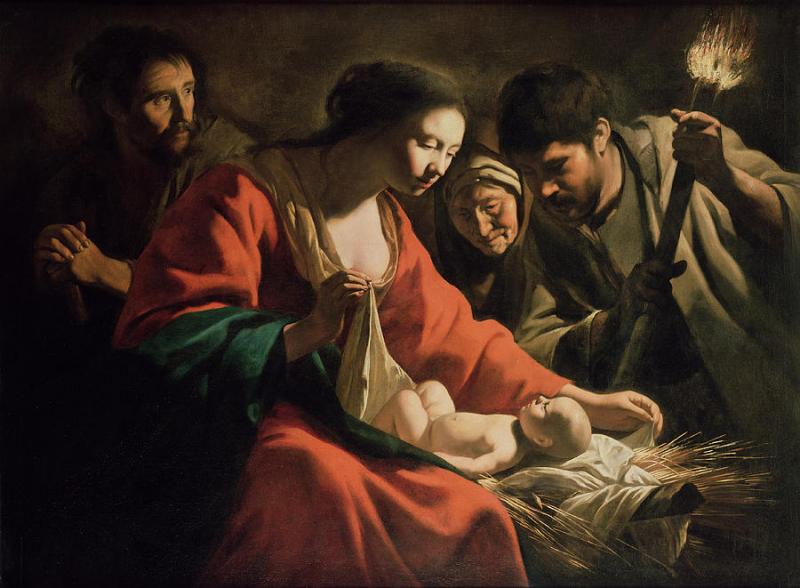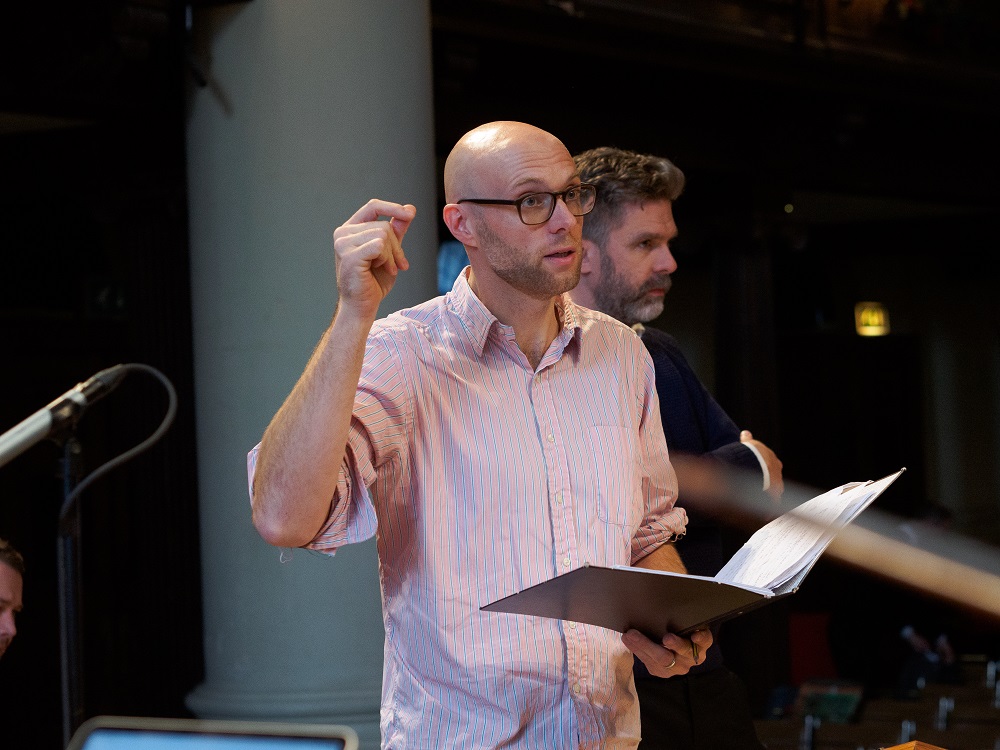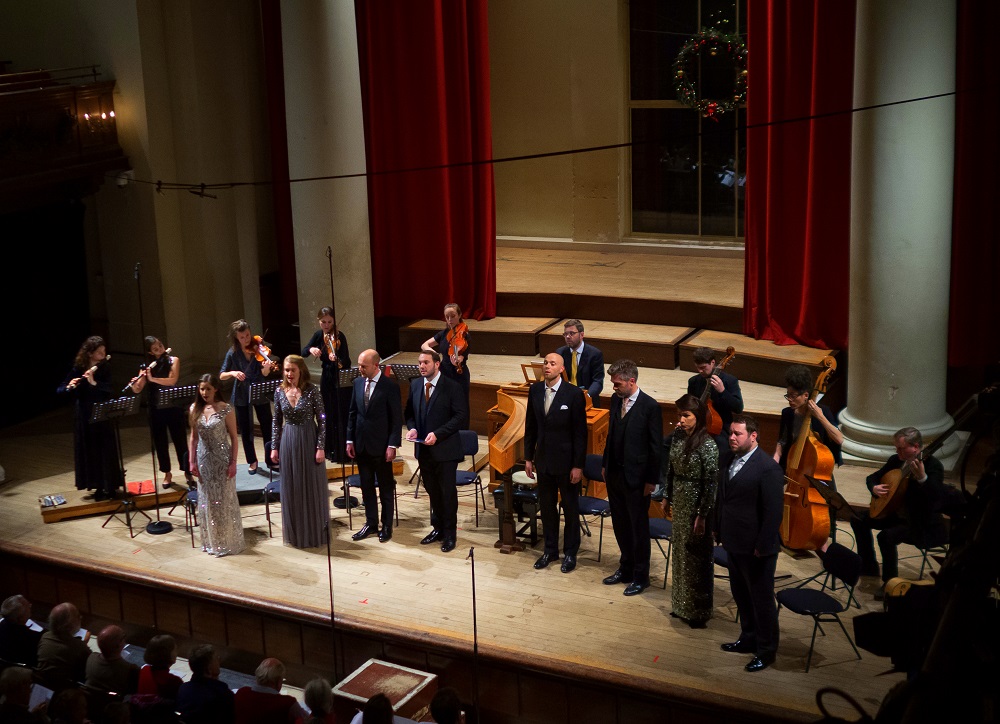Charpentier Christmas settings, Solomon's Knot, St John's Smith Square review - pastoral shades | reviews, news & interviews
Charpentier Christmas settings, Solomon's Knot, St John's Smith Square review - pastoral shades
Charpentier Christmas settings, Solomon's Knot, St John's Smith Square review - pastoral shades
Vibrancy in excelsis for two varied and tender 17th century curiosities

There is no mention of Marc-Antoine Charpentier in David Cairns's comprehensive Berlioz biography.
Would an all-Charpentier evening be too much of a good thing? At the end of the slightly later In navitatem Domini canticum, the first-half work, sympathetic presenter, bass and founding artistic director Jonathan Sells (pictured below in rehearsal with Alex Ashworth, first of two images by Alexander Barnes/Apple and Biscuit) announced that if we'd had enough of Charpentier, we could buy the group's new CD of Bach's Magnificat. Strange to think that in the year of the Pastorale, a boy was born in Eisenach who would become the most wonderful of all.  No, Charpentier doesn't entirely transcend the manners of his Lully-centric Parisian time; the wonders are more in the sequences and contrasts of two works that begin with mankind in dire need of salvation, proceed gently with two instrumental night pictures conventional in essence but moving in presentation - especially the string-quintet magic of In nativitatem - and then set shepherds dancing with good news (Sells' tambourine joining the other players).
No, Charpentier doesn't entirely transcend the manners of his Lully-centric Parisian time; the wonders are more in the sequences and contrasts of two works that begin with mankind in dire need of salvation, proceed gently with two instrumental night pictures conventional in essence but moving in presentation - especially the string-quintet magic of In nativitatem - and then set shepherds dancing with good news (Sells' tambourine joining the other players).
In fact there was sufficient contrast between the two works: In nativitatem slightly more austere as well as shorter, in church Latin for St Paul-St Louis in the Marais, with its unique halting reminder of Christ born into poverty ("you are so needy, you cry so, you are so cold, you love so"), the Pastorale composed to a more naive French text for the household of Mademoiselle de Guise (with the added pathos that the last male heir of the house of Guise had died at the age of five a decade earlier). Its highlights - detachable if anyone's looking for special Christmas numbers - are the "Gloire"s of four angels (the women's spangly tops and dresses paying off here as visual complement to singing vibrant in excelsis) and the simple but touching polyphony of the final shepherd's chorus, with a beautiful phrase resounding as it's passed around each voice-part). What a talented household of singers, chambermaids included, the Hotel de Guise's must have been.  Solos were taken with character, even if in their dramatic presentation most of Solomon's Knot could do with a lesson or two in learning to stand naturally and seem relaxed (Marcus Farnsworth, with plenty of stage experience, is used to it). The group is lucky, or has simply chosen well, to have a clarion high tenor in Peter Davoren, crucial in the first of the evening's works, and a true bass in Alex Ashworth. Claire Lloyd-Griffiths brought light and intensity as the Pastorale's announcing Angel - originally sung by a clearly talented 20 year old soprano - and Zoë Brookshaw landed the plum cameo of a shepherdess lamenting the death of her favourite ewe, devoured by a wolf while most of the others have rushed off to see the Christ Child. Fatuously, one might suggest a final touch à la Peter and the Wolf - the sheep, swallowed whole, bleating from within the belly of the beast - but by the end, Charpentier has turned universal before a final joyous dance march.
Solos were taken with character, even if in their dramatic presentation most of Solomon's Knot could do with a lesson or two in learning to stand naturally and seem relaxed (Marcus Farnsworth, with plenty of stage experience, is used to it). The group is lucky, or has simply chosen well, to have a clarion high tenor in Peter Davoren, crucial in the first of the evening's works, and a true bass in Alex Ashworth. Claire Lloyd-Griffiths brought light and intensity as the Pastorale's announcing Angel - originally sung by a clearly talented 20 year old soprano - and Zoë Brookshaw landed the plum cameo of a shepherdess lamenting the death of her favourite ewe, devoured by a wolf while most of the others have rushed off to see the Christ Child. Fatuously, one might suggest a final touch à la Peter and the Wolf - the sheep, swallowed whole, bleating from within the belly of the beast - but by the end, Charpentier has turned universal before a final joyous dance march.
The sunrise aspect is fascinating, too, especially as text (the sun illumines only half the world; Christ is all-encompassing): a special salute there to artistic advisor James Halliday for fusing versions to give a London premiere of sorts. The encore, Charpentier's O oriens, encapsulated the twin poles of gravity and tripping joy. Who couldn't feel the better for hearing this?
rating
Explore topics
Share this article
The future of Arts Journalism
You can stop theartsdesk.com closing!
We urgently need financing to survive. Our fundraising drive has thus far raised £49,000 but we need to reach £100,000 or we will be forced to close. Please contribute here: https://gofund.me/c3f6033d
And if you can forward this information to anyone who might assist, we’d be grateful.

Subscribe to theartsdesk.com
Thank you for continuing to read our work on theartsdesk.com. For unlimited access to every article in its entirety, including our archive of more than 15,000 pieces, we're asking for £5 per month or £40 per year. We feel it's a very good deal, and hope you do too.
To take a subscription now simply click here.
And if you're looking for that extra gift for a friend or family member, why not treat them to a theartsdesk.com gift subscription?
more Classical music
 Lammermuir Festival review: music with soul from the heart of East Lothian
Baroque splendour, and chamber-ensemble drama, amid history-haunted lands
Lammermuir Festival review: music with soul from the heart of East Lothian
Baroque splendour, and chamber-ensemble drama, amid history-haunted lands
 BBC Proms: Steinbacher, RPO, Petrenko / Sternath, BBCSO, Oramo review - double-bill mixed bag
Young pianist shines in Grieg but Bliss’s portentous cantata disappoints
BBC Proms: Steinbacher, RPO, Petrenko / Sternath, BBCSO, Oramo review - double-bill mixed bag
Young pianist shines in Grieg but Bliss’s portentous cantata disappoints
 theartsdesk at the Lahti Sibelius Festival - early epics by the Finnish master in context
Finnish heroes meet their Austro-German counterparts in breathtaking interpretations
theartsdesk at the Lahti Sibelius Festival - early epics by the Finnish master in context
Finnish heroes meet their Austro-German counterparts in breathtaking interpretations
 Classical CDs: Sleigh rides, pancakes and cigars
Two big boxes, plus new music for brass and a pair of clarinet concertos
Classical CDs: Sleigh rides, pancakes and cigars
Two big boxes, plus new music for brass and a pair of clarinet concertos
 Waley-Cohen, Manchester Camerata, Pether, Whitworth Art Gallery, Manchester review - premiere of no ordinary violin concerto
Images of maternal care inspired by Hepworth and played in a gallery setting
Waley-Cohen, Manchester Camerata, Pether, Whitworth Art Gallery, Manchester review - premiere of no ordinary violin concerto
Images of maternal care inspired by Hepworth and played in a gallery setting
 BBC Proms: Barruk, Norwegian Chamber Orchestra, Kuusisto review - vague incantations, precise laments
First-half mix of Sámi songs and string things falters, but Shostakovich scours the soul
BBC Proms: Barruk, Norwegian Chamber Orchestra, Kuusisto review - vague incantations, precise laments
First-half mix of Sámi songs and string things falters, but Shostakovich scours the soul
 BBC Proms: Alexander’s Feast, Irish Baroque Orchestra, Whelan review - rapturous Handel fills the space
Pure joy, with a touch of introspection, from a great ensemble and three superb soloists
BBC Proms: Alexander’s Feast, Irish Baroque Orchestra, Whelan review - rapturous Handel fills the space
Pure joy, with a touch of introspection, from a great ensemble and three superb soloists
 BBC Proms: Moore, LSO, Bancroft review - the freshness of morning wind and brass
English concert band music...and an outlier
BBC Proms: Moore, LSO, Bancroft review - the freshness of morning wind and brass
English concert band music...and an outlier
 Willis-Sørensen, Ukrainian Freedom Orchestra, Wilson, Cadogan Hall review - romantic resilience
Passion, and polish, from Kyiv's musical warriors
Willis-Sørensen, Ukrainian Freedom Orchestra, Wilson, Cadogan Hall review - romantic resilience
Passion, and polish, from Kyiv's musical warriors
 BBC Proms: Faust, Gewandhausorchester Leipzig, Nelsons review - grace, then grandeur
A great fiddler lightens a dense orchestral palette
BBC Proms: Faust, Gewandhausorchester Leipzig, Nelsons review - grace, then grandeur
A great fiddler lightens a dense orchestral palette
 BBC Proms: Jansen, Royal Concertgebouw Orchestra, Mäkelä review - confirming a phenomenon
Second Prom of a great orchestra and chief conductor in waiting never puts a foot wrong
BBC Proms: Jansen, Royal Concertgebouw Orchestra, Mäkelä review - confirming a phenomenon
Second Prom of a great orchestra and chief conductor in waiting never puts a foot wrong
 BBC Proms: Royal Concertgebouw Orchestra, Mäkelä review - defiantly introverted Mahler 5 gives food for thought
Chief Conductor in Waiting has supple, nuanced chemistry with a great orchestra
BBC Proms: Royal Concertgebouw Orchestra, Mäkelä review - defiantly introverted Mahler 5 gives food for thought
Chief Conductor in Waiting has supple, nuanced chemistry with a great orchestra

Add comment